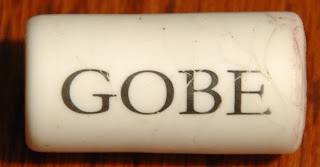In the village of Porrera, as in the rest of Priorat, there are few wineries, apart from cooperatives, that have been in business as such for more that twenty years, when the Priorat revolution started. Modern Priorat wineries can be divided in two groups, which I think are well represented by the two Porrera enterprises I will now describe.
Ferrer Bobet is a joint venture between Sergi Ferrer-Salat, owner of one of the largest Catalan pharma companies and acknowledged food and wine enthusiast, and Raül Bobet, famed oenologist at Torres. They purchased land over the winding road that leads from Porrera to Falset. There they planted 20 hectares of Garnatxa, Carinyena, Syrah, Cabernet Sauvignon and Viognier, and built a spectacular, if discrete, cellar with a distinctive semicircular glass walled tasting room with fabulous views.
Grapes from these new plots are not yet used: vines are too young. Rather, Ferrer Bobet buys grapes from selected vinegrowers that organically farm costers planted with old Carinyena and Garnatxa. Grapes are harvested manually in small boxes, taken immediately to the winery and stored at 3 ºC. Grapes are then selected manually before destemming and after.
Inside of the cellar, and mainly underground, the latest technology and stainless steel combine with the best wood to enable organic winemaking with gravity powered wine movements. The pharmaceutical background of Sergi Ferrer (I am also in the pharma industry) shows in the attention to cleanliness and the careful choice of materials in contact with wine.
Fermentation takes place in smallish oak vats, allowing separation of individual vineyards. Later on wine ages for fifteen to eighteen months in new French oak and twelve months in bottle.
Ferrer Bobet produces only two reds, both coming from the old vine costers:
- Ferrer Bobet, with about two thirds Carinyena and on third Garnatxa, with the occasional sprinkling of Cabernet Sauvignon or Syrah
- Ferrer Bobet Selecció Especial, with over 85% Carinyena and the balance for Garnatxa.
The winery produces a total of around 25’000 bottles of these intense, elegant, mineral and fruity reds.
Joan Simó is a winery located in the centre of Porrera, in a two hundred year old house, complete with sundial. Gerard Batllevell Simó, the owner, farms land from his family and also other plots more recently purchased. In 1999 and 2000 he planted Garnatxa, Carinyena, Cabernet Sauvignon and Syrah in La Garranxa, a plot that had been barren since the phylloxera onslaught.
Winemaking facilities are located in the lower part of the Porrera house, with the dimensions of a garage winery. Still active, Gerard's uncle gives advice and produces a superb ranci, or oxidized wine, that unfortunately is not for sale.
Gerard makes three wines, all red:
- Sentius, from Garnatxa, Carinyena, Cabernet Sauvignon and Syrah from La Garranxa. Fifteen months in French oak.
- Les Eres, the flagship of the winery, is made with grapes of four different plots, using Garnatxa and Carinyena eighty to ninety years old, and some younger Cabernet Sauvignon. The wine is kept for eighteen months in new French oak.
- And since 2006, Les Eres Especial Els Carners, 550 bottles coming from the Els Carners plot, planted ninety years ago with Garnatxa and Carinyena (75/25). Two barrels, one of Allier and the other of Tronçais oak, hold the wine for eighteen months.
All three are dark, concentrated, complex examples of Priorat. Total production of around 20'000 bottles.
The two different ways are clear. On one hand the external money from a wealthy wine lover that is invested intensively, starting with a spectacular winery and building the wine later. What we call in Catalan to start building the house by the roof. On the other, the local step by step approach, using money only when needed and not before, utilizing old village houses and vines from the family or purchased at the cost of personal involvement.
Which is best?
I tend to judge them looking at two variables mainly: the impact on the land and its economy and, of course, the quality of the wines. For the first group, respect to the environment and to free trade, trying not to dominate the market, and contributing to local economy can have a very positive impact. The second strategy permits in the long term local accumulation of wealth and better prospects for the young.
I think we can find examples of better and worse wineries in both groups. In the first, I find that much depends on the personality of the capital provider. If he is personally involved, has not invested a critical part of his wealth and has the good sense to listen to expert professionals, chances are good. If some of these conditions are not met, and a crisis pushes the market down, chances of survival are slim, as can be seen just now in some sad cases.
In the second group, chance of survival is more linked to the quality of the wine and the way it is marketed, often the great weakness.
A third way is when foreign winemakers invest, but I think they tend to be more cautious and mimic the step by step approach of the locals, I do not know if out of experience or lack of money.
For me, a good blend of strategies is likely to benefit Priorat (or any other zone in a similar situation) and the wine lovers. Ferrer Bobet and Joan Simó do.

























